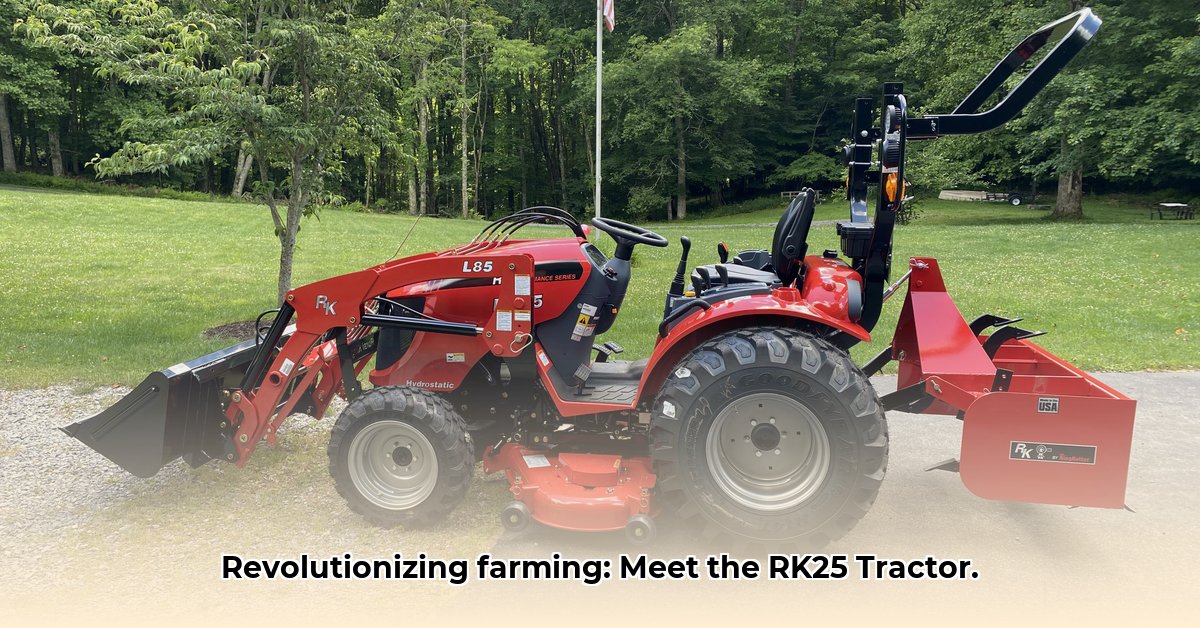
The RK25H subcompact tractor presents a compelling case for sustainable agriculture, promising fuel efficiency and versatility. But does it deliver on its promise? This article provides a balanced assessment of its environmental impact, exploring its strengths and weaknesses to inform farmers' decisions. We'll analyze fuel efficiency, versatility, tire choices, maintenance, and the broader environmental considerations to paint a complete picture. Ultimately, we aim to provide actionable insights for farmers, manufacturers, and policymakers. For more on tractor types, see this helpful guide: tractor types.
Fuel Efficiency: A Lean, Green Machine?
The RK25H's 24-horsepower Yanmar Tier 4 diesel engine is designed for efficiency. Its lower horsepower, compared to larger tractors, translates to significantly reduced fuel consumption. This directly impacts both operating costs and the tractor's carbon footprint. Lower fuel usage means less money spent and fewer greenhouse gas emissions – a benefit for both your wallet and the environment. But how does its fuel efficiency stack up against larger tractors performing similar tasks? Further comparative data would strengthen this assessment.
Versatility: Adapting to Diverse Needs
The RK25H’s versatility is a key selling point. Its compatibility with a wide array of attachments—from loaders and backhoes to mowers—allows it to perform various tasks. This reduces the need for multiple specialized machines, saving space and minimizing the environmental impact associated with manufacturing, transport, and storage of extra equipment. However, the effective utilization of this versatility depends on farmers' specific needs and operational scale.
Tire Talk: Balancing Performance and Environmental Impact
Tire selection significantly influences the RK25H's performance and environmental footprint. Options include R3 turf tires, known for minimizing soil compaction but potentially having a shorter lifespan compared to other types. This presents a trade-off: minimize soil disturbance or maximize tire longevity? A life cycle assessment (LCA) comparing different tire types would provide crucial data for informed decision-making. The long-term environmental and economic consequences of each tire choice must be carefully weighed. Is the reduced soil compaction from R3 tires enough to offset their shorter lifespan and the need for more frequent replacements?
Long-Term Sustainability: Maintenance and Lifecycle
The RK25H boasts an impressive eight-year powertrain warranty, suggesting robust build quality. However, long-term sustainability isn't solely about initial build quality; regular maintenance is crucial. Oil changes, filter replacements, and timely repairs extend operational life and minimize waste. A comprehensive LCA, encompassing the entire life cycle from manufacturing to eventual disposal, is needed for a complete environmental assessment. Understanding the environmental impact of manufacturing processes and responsible disposal/recycling is vital.
The Bigger Picture: Indirect Emissions
The RK25H's environmental impact extends beyond operational fuel consumption. Indirect emissions associated with its manufacturing, transportation, and eventual disposal must be considered. Sustainable manufacturing practices (e.g., using recycled materials and renewable energy) significantly influence its overall carbon footprint. Similarly, the availability of recycling or responsible disposal options at the end of its lifespan plays a crucial role. Data on these aspects is essential for a complete and truthful picture.
Total Cost of Ownership (TCO): A Holistic View
Farmers must consider the Total Cost of Ownership (TCO), encompassing initial purchase price, fuel costs, maintenance, repairs, and tire replacements. A detailed TCO analysis, compared to alternative tractors, is crucial for assessing its long-term cost-effectiveness and alignment with sustainable farming goals. Accurate TCO calculation requires thorough record-keeping, diligent maintenance, and realistic projections for repairs. This analysis will illuminate the long-term financial commitment.
Recommendations for a Sustainable Future: A Collaborative Approach
Realizing the full potential of sustainable agricultural machinery requires collaboration among stakeholders.
| Stakeholder | Short-Term Actions | Long-Term Actions |
|---|---|---|
| Farmers/Landowners | Assess operational needs; choose appropriate tires; maintain detailed records. | Conduct thorough TCO analysis; plan for responsible maintenance and tire disposal. |
| RK Manufacturers | Increase transparency; publicly share LCA results; invest in sustainable manufacturing. | Invest further in R&D for sustainable materials and manufacturing processes. |
| Policy Makers | Provide financial incentives for sustainable machinery. | Develop and implement regulations for responsible equipment disposal and recycling programs. |
Conclusion: Weighing the Evidence
The RK25H tractor presents potential benefits for sustainable agriculture, primarily through its fuel efficiency and versatility. However, a comprehensive assessment necessitates further research on its total environmental impact, particularly concerning indirect emissions and life-cycle analysis. Transparency from manufacturers, coupled with responsible decision-making by farmers and supportive policies from lawmakers, will be vital for realizing the full potential of this and similar technologies in creating a truly sustainable agricultural future.